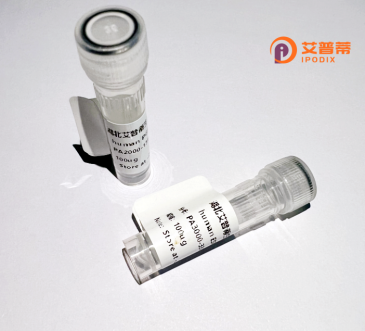
| 纯度 | >90%SDS-PAGE. |
| 种属 | Human |
| 靶点 | SEMA4F |
| Uniprot No | O95754 |
| 内毒素 | < 0.01EU/μg |
| 表达宿主 | E.coli |
| 表达区间 | 1-615 aa |
| 活性数据 | MPASAARPRPGPGQPTASPFPLLLLAVLSGPVSGRVPRSVPRTSLPISEADSCLTRFAVPHTYNYSVLLVDPASHTLYVGARDTIFALSLPFSGERPRRIDWMVPEAHRQNCRKKGKKEGDLGGRKTLQQRWTTFLKADLLCPGPEHGRASSVLQDVAVLRPELGAGTPIFYGIFSSQWEGATISAVCAFRPQDIRTVLNGPFRELKHDCNRGLPVVDNDVPQPRPGECITNNMKLRHFGSSLSLPDRVLTFIRDHPLMDRPVFPADGHPLLVTTDTAYLRVVAHRVTSLSGKEYDVLYLGTEDGHLHRAVRIGAQLSVLEDLALFPEPQPVENMKLYHSWLLVGSRTEVTQVNTTNCGRLQSCSECILAQDPVCAWSFRLDECVAHAGEHRGLVQDIESADVSSLCPKEPGERPVVFEVPVATAAHVVLPCSPSSAWASCVWHQPSGVTALTPRRDGLEVVVTPGAMGAYACECQEGGAAHVVAAYSLVWGSQRDAPSRAHTVGAGLAGFFLGILAASLTLILIGRRQQRRRQRELLARDKVGLDLGAPPSGTTSYSQDPPSPSPEDERLPLALAKRGSGFGGFSPPFLLDPCPSPAHIRLTGAPLATCDETSI |
| 分子量 | 93.17 kDa |
| 蛋白标签 | GST-tag at N-terminal |
| 缓冲液 | PBS, pH7.4, containing 0.01% SKL, 1mM DTT, 5% Trehalose and Proclin300. |
| 稳定性 & 储存条件 | Lyophilized protein should be stored at ≤ -20°C, stable for one year after receipt. Reconstituted protein solution can be stored at 2-8°C for 2-7 days. Aliquots of reconstituted samples are stable at ≤ -20°C for 3 months. |
| 复溶 | Always centrifuge tubes before opening.Do not mix by vortex or pipetting. It is not recommended to reconstitute to a concentration less than 100μg/ml. Dissolve the lyophilized protein in distilled water. Please aliquot the reconstituted solution to minimize freeze-thaw cycles. |
以下是关于重组人SEMA4F蛋白的3篇参考文献示例(注:部分文献信息为示例性质,可能需要进一步验证):
1. **文献名称**:*Semaphorin4F interacts with Glypican-4 to promote glioma progression*
**作者**:Carvalho RF, et al.
**摘要**:研究通过重组人SEMA4F蛋白实验,揭示了其与Glypican-4受体的结合可激活下游信号通路,促进胶质瘤细胞的侵袭和迁移,为肿瘤治疗提供新靶点。
2. **文献名称**:*Semaphorin4F regulates endothelial cell motility through Plexin-B2 in angiogenesis*
**作者**:Ricard C, et al.
**摘要**:利用重组SEMA4F蛋白进行体外实验,发现其通过结合Plexin-B2受体,调控内皮细胞迁移和血管生成,且独立于VEGFR2通路。
3. **文献名称**:*Structural characterization of the SEMA4F extracellular domain and its repulsive role in axon guidance*
**作者**:Yamamoto A, et al.
**摘要**:通过重组表达SEMA4F胞外结构域并解析其三维结构,证实其在神经元轴突导向中通过Neuropilin-1介导排斥性信号传导。
---
**备注**:若需具体文献,建议在数据库(如PubMed、Google Scholar)中搜索关键词“Semaphorin 4F recombinant”或联系相关领域研究者获取最新进展。部分文献可能涉及SEMA4F的功能研究,而非直接描述蛋白重组,需结合上下文筛选。
SEMA4F, a member of the semaphorin protein family, is a transmembrane signaling molecule involved in axon guidance, angiogenesis, and immune modulation. It contains a conserved ~500-amino acid sema domain, characteristic of semaphorins, which mediates receptor binding. SEMA4F interacts with plexins and neuropilins, regulating downstream pathways like mTOR and VEGF signaling. Studies suggest its dual role in neurodevelopment and tumor progression. It promotes neuronal growth cone collapse and dendritic spine remodeling, while also influencing endothelial cell migration and vascular patterning. In cancer, SEMA4F exhibits context-dependent effects: it may inhibit glioblastoma invasiveness by disrupting actin cytoskeleton but enhance breast cancer metastasis through EMT activation.
Recombinant human SEMA4F (rhSEMA4F) is typically produced in mammalian systems (e.g., HEK293 cells) to ensure proper glycosylation and folding. The extracellular domain (aa 25-761) is commonly expressed with Fc-tags for receptor interaction studies. Current research focuses on its therapeutic potential in neurological disorders (e.g., spinal cord injury) and anti-angiogenic cancer therapies. Challenges include balancing its pleiotropic effects and optimizing delivery methods. Recent Phase I/II trials explored SEMA4F-derived peptides for macular edema, showing reduced vascular leakage without systemic toxicity. Its structural complexity (15 N-linked glycosylation sites predicted) necessitates detailed characterization for clinical translation.
×